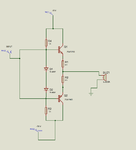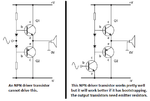julian403
Full Member level 5
Hi I still doing the power amplifier. I made the next power ampliffier step

Icmax= 4.3 [A] and the HFE is about 100 so I need a Ibmax=0.03 [A]. But I do not know how make the driver step.
I thought use a TIP41 as commun emitter

Where the output of this step is on colector. So, the output impedance that it will see is:
10 [KΩ] // (8.1 [Ω])(HFE+1)
Where the last HFE is the 2SA5200's HFE. But when I try it on the simulator it does not work. What do you thinks? What I must use as driver step? (to drive a current of 0.03[A] on the 2SA... transitor's base?

Icmax= 4.3 [A] and the HFE is about 100 so I need a Ibmax=0.03 [A]. But I do not know how make the driver step.
I thought use a TIP41 as commun emitter

Where the output of this step is on colector. So, the output impedance that it will see is:
10 [KΩ] // (8.1 [Ω])(HFE+1)
Where the last HFE is the 2SA5200's HFE. But when I try it on the simulator it does not work. What do you thinks? What I must use as driver step? (to drive a current of 0.03[A] on the 2SA... transitor's base?









